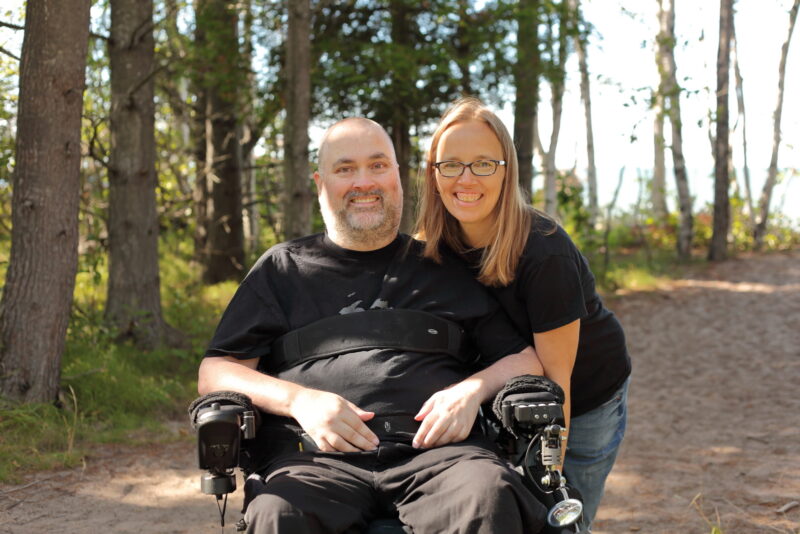Perspective: What I learned in 13 years of ALS caregiving

At first, my husband’s amyotrophic lateral sclerosis (ALS) diagnosis felt like a death sentence — I did not fully comprehend what lay ahead in Todd’s long journey of progressive disability. And the challenges that would come with being his caregiver over the past 13 years were not even on my radar.
After Todd was diagnosed, I grieved that our two young children would lose their father, and I grieved the loss of our dreams. The prognosis of two to five years hung over our heads. After the first year, Todd’s neurologist said the ALS was progressing relatively slowly and he’d probably make it to the five-year mark.
In those early days when Todd’s arms were weak, he needed my help to button his shirt and shave his cheeks. Running a razor across Todd’s face felt overwhelming. It seems like a small thing now in light of him being paralyzed and needing noninvasive ventilation, but at the time, I couldn’t believe my once-strong husband was so quickly losing basic abilities.
The losses piled on, and my grief continued. I took on more of the household chores along with increasingly more of Todd’s personal care.
Need for support
After the diagnosis Todd told me, “We need to sell the house. We need to move near your parents so you’ll have help.”
ALS is a tough disease. I need help caring for Todd, and I need day-to-day support. For several years, my dad helped with the type of things that Todd used to do around the house, but he died seven years ago. My mom continues to help.
Some friends, along with our church community, have been generous with financial gifts so that we can hire nighttime caregivers. And we have friends who are willing to help with household tasks that require more mechanical skills than I have.
For managing the difficulties specific to ALS, I draw on the experiences from others in the ALS community.
ALS clinics
For the first few years, we attended an ALS clinic every six months. We had back-to-back appointments — a respiratory therapist, occupational therapist, social worker, and the neurologist — all in one day. The days were exhausting, and yet so helpful. After Todd’s appointments, we would go to a support group. It was encouraging to be with others who were dealing with the same challenges.
After Todd progressed to the point when travel was difficult, we stopped attending clinic and we had to piece together resources in our rural community. By that point, we had enough experience to know what we needed, and wherever my knowledge fell short, I relied on the help of the ALS community online.
Social media
I’ve connected with other caregivers through ALS Facebook groups. We are all in the trenches together, learning as we go. Recently someone posted a video of her family’s first attempt using a Hoyer floor lift and asked for feedback. Many other caregivers weighed in with encouragement and suggestions.
I’ve also connected with other caregivers who are in a similar life stage with young families. Social media is a way to connect and find practical and emotional support.
Limited resources
Time and time again, a spouse caregiver who is new to ALS will ask a reiteration of the same question: “How do I get someone to care for my spouse while I’m at work?”
The answer is shocking: There isn’t significant help available in the U.S. Medicare allows for home care in certain disciplines, such as physical therapy. If that treatment is prescribed, home health agencies might be willing to provide a bath aide for a shower or two per week. In rare cases, people have had the foresight to purchase long-term care policies, and others are eligible for veteran benefits. Those in the unenviable position of having little income and few assets may qualify for Medicaid and get some home care hours. But even in those cases, agencies are often short-staffed.
For the most part, family caregivers are on their own, or they must recruit volunteers or raise funds to pay out of pocket for help.
Learning on the job
Most spouse caregivers have a steep learning curve.
I recall the uncertainty and anxiety of putting Todd in a sling to safely transfer him to his bed, making sure the leg straps were crossed so he wouldn’t topple out the front. I’ve had to learn to flush his feeding tube and clean his stoma. I’ve dealt with his skin breakdown and other wounds. I manually assist Todd’s coughs so he can clear his lungs. I learned about cough assist machines and noninvasive ventilation. I clear his sinuses with a suction machine.
I’ve also had to learn Medicare rules and how to navigate our healthcare system. I raise funds. I recruit help and navigate tax law and payroll requirements.
There’s a lot to know, and with all the demands on caregivers, there is little time left to care for ourselves.
Breaking point
I was sleep deprived for two years, and I wasn’t doing well. Over the course of a few years, Todd slowly lost his ability to sleep independently. He woke me up ever more frequently — to roll him over, scratch an itch, or adjust a limb. I hadn’t even completed a full sleep cycle before being awoken. Then, after I helped him, I wasn’t able to fall back asleep, not knowing if he’d need me again in five minutes.
We tried various alternating air mattresses, but they didn’t help Todd sleep, and we didn’t want him to take medication that would depress his breathing. I was at my breaking point, and I didn’t want our kids to lose two parents to this disease.
Something had to change so I could get enough sleep.
We began fundraising in order to hire nighttime help to turn him at night so I could sleep. We’ve had to recruit and pay people directly, because the home health agencies in our area currently don’t have enough staff willing to work nights. We’ve hired certified nursing assistants, nurses, and people with no medical training at all.
Ways I recharge
As hard as it was to break away, I committed to popping into a gym for a half-hour every day. And then when gyms closed during the pandemic, I began cross-country skiing in the winter and walking in the summer. I prefer exercising outdoors, as being in the beauty of nature feeds my soul. Many days, I just walk around the field near our home so I can easily return if Todd needs help.
I’ve recently been attending a weekly ukulele group that’s less than 10 minutes away, so I can get home quickly if needed. It’s good to get out of the house and have a pursuit that’s a diversion from ALS.
I’ve also taken a few spring break trips with our kids. Even though it’s a major undertaking to arrange 24-hour care for a few days, it’s good for my mental health to have that extended break once a year.
Every journey is different
It has been a hard 13 years, but we’ve had joy along with the ongoing sorrow. Our kids have grown up with a father who knows and loves them. And Todd has provided me with emotional support. He’s still my partner in co-parenting the children, and he offers advice and coaching on household projects.
Our situation is unique to us. Everyone dealing with ALS has different challenges. Resources vary, and the disease progresses differently in each person. Progression in some people is so fast there’s barely time to react. In other cases, caregivers can prepare for the next step.
Must-knows
Even though the progression of ALS varies, most people end up in the same place. They lose their ability to walk. They lose their ability to talk. They lose their ability to swallow and breathe. Fortunately, technology can prolong life and help people live higher-quality lives. It’s best to get the equipment in place before it’s absolutely needed.
My husband took a few falls before he agreed to use a wheelchair. He bloodied his face in one of those falls, but fortunately, he didn’t suffer serious injury. Some people with ALS never recover after a bad fall.
In the U.S., Medicare pays for one wheelchair every five years, so make sure to use Medicare to get a custom-fitted, power chair that tilts and reclines. Before you qualify for or need the custom chair, borrow a wheelchair from a loan closet or find a used chair online. It takes time to order the custom chair, so start the process early.
Make sure you advocate for resources. When Todd needed a head array to drive his wheelchair, the durable medical provider was hesitant to order it because they were concerned that the documentation wasn’t strong enough for Medicare to cover it. I knew it should be covered, and so I petitioned upper management. The company agreed to cover it, and Medicare eventually paid for it.
So here we are, having gone through more than a decade of the disease progression. We’ve learned a lot, and somehow we’re still going.
Note: ALS News Today is strictly a news and information website about the disease. It does not provide medical advice, diagnosis, or treatment. This content is not intended to be a substitute for professional medical advice, diagnosis, or treatment. Always seek the advice of your physician or other qualified health provider with any questions you may have regarding a medical condition. Never disregard professional medical advice or delay in seeking it because of something you have read on this website. The opinions expressed in this column are not those of ALS News Today or its parent company, BioNews, and are intended to spark discussion about issues pertaining to ALS.
About the Author

Kristin Neva is an author, mother of two, and caregiver for her husband, Todd, who was diagnosed with ALS in 2010 when he was 39 years old. Knowing they would need family support, they moved to Upper Michigan and built an accessible home on property next to Kristin’s childhood home. Kristin enjoys spending time outdoors, especially on the shore of Lake Superior in the summer. Todd no longer has use of his limbs, but he stays active working on projects on his computer using adaptive technology. They try to find joy in the midst of sorrow as Todd’s health declines.
Recent Posts
- Lessons for living with ALS from my recent nature walk
- Extended treatment with NurOwn may offer additional benefits in ALS
- Protein interaction may lead to new strategy for treatment of ALS
- These bathroom safety modifications were a great decision
- NeuroSense taps machine learning to optimize PrimeC Phase 3 testing
Related Articles






